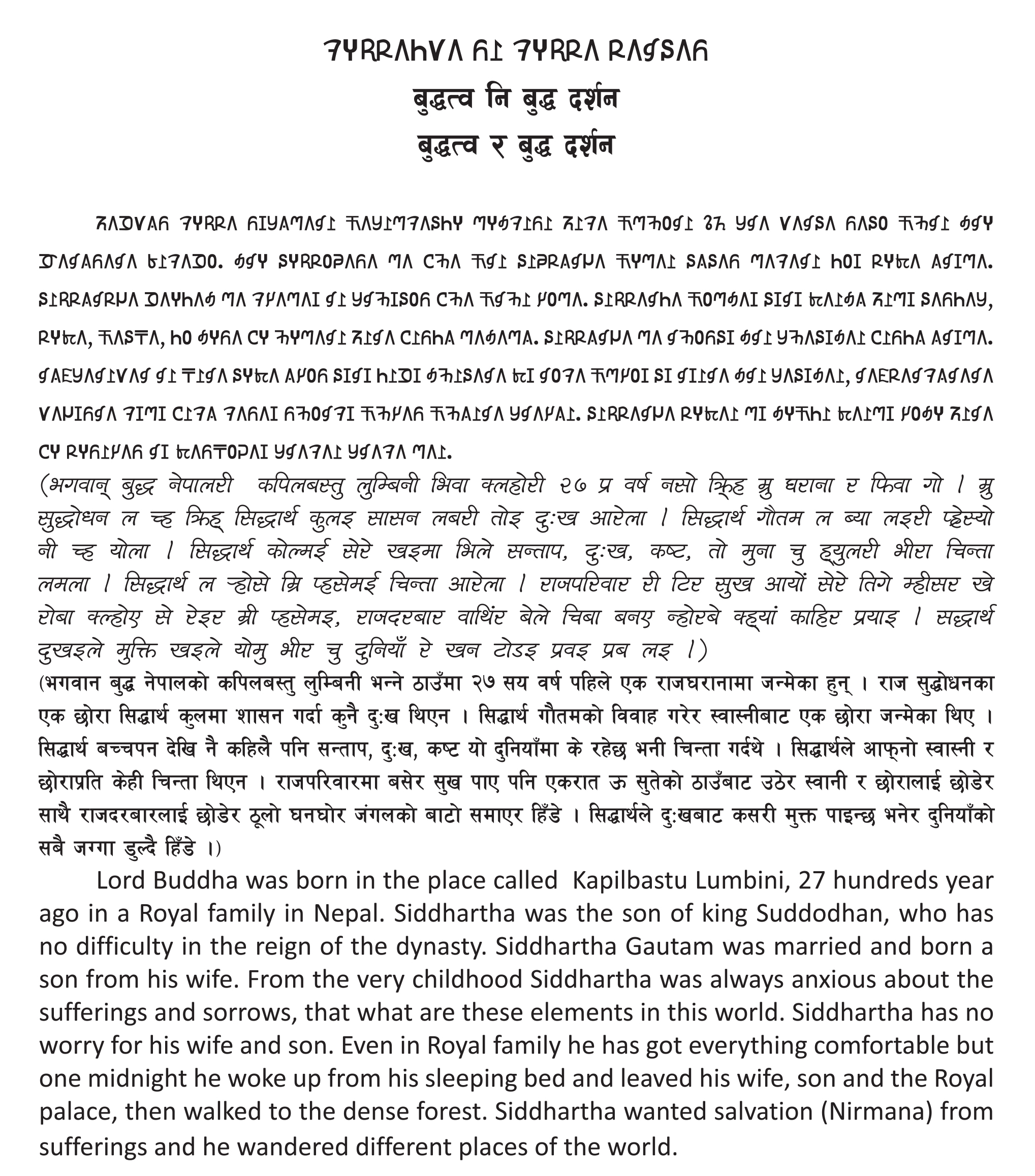Culture & Lifestyle
The Gurung language once had no written script. Now it has five
In an effort to preserve its oral language, the Gurung community came up with its own scripts, but it is now divided over which to use.-copy.jpg&w=900&height=601)
Sachitra Gurung
In 1944, when Jagan Lal Gurung was fighting in Burma during the Second World War, he came up with an ingenious method of communication. As his battalion was composed primarily of Gurungs, Jagan Lal began to communicate in Tamu kyui, the Gurung language. When the war ended, Jagan Lal had acquired a newfound interest in his native tongue, an interest that led to him developing a script for the oral language.
Combining various signs and symbols, Jagan Lal developed a rudimentary script, which today is known as Khe Prih. When Jagan Lal returned to Nepal, he began teaching Khe Prih to the children in his village of Hyanjakot.
“It was still the Rana regime in Nepal at that time,” said Man Bahadur Gurung, president of the Tamu Language-Script and Culture Development Foundation in Lekhnath, Kaski, and a long-time advocate of Khe Prih. “Jagan solti received a lot of threats from the Ranas for teaching the children, but he didn’t budge. When he was about to be arrested and his life was at stake, he ran away from Nepal, back to his duty in the Indian Army.”
Jagan Lal only came back to Nepal in 1965, and immediately began lobbying for his beloved script. He taught many, with Man Bahadur among them. But he made little progress in his lifetime. After Jagan Lal’s death in 2011, Man Bahadur edited the Khe Prih script into its current form and began to propagate it.
“Jagan solti did a lot to teach Gurungs to write in their own script,” says Man Bahadur. “But at that time, people cared less about having a cultural identity.”
But Jagan Lal’s Khe Prih wasn’t the only script vying for the attention of the Gurung community. Quite a few others had attempted to develop a script for the language, even as some believed that a script was unnecessary, as they could easily write out the Tamu kyui using Devanagari or even Latin alphabets.
According to the 2011 Nepal census, there were 522,641 Gurungs in the country, but only 325,622 could speak the language and a majority of them live in villages. Despite this, the language has five scripts—Khema, Khe Prih, Shaman, Roman, and Ujjain.
Khe Prih and Khema are the two most widely used scripts, and although Khe Prih is older, Khema is much more popular, used in Nepal, India and Bhutan and also listed as the official script of the Gurung language by the Nepal Language Commission.
Despite Jagan Lal’s efforts, Khe Prih was never fully adopted by the Gurung community, which was largely unaware of its existence. The Gurung began to fear that the language would disappear as more and more Gurungs started to live abroad and not speak the language. And since it couldn’t be written down, the fear was even more palpable, according to Bal Narsingh Gurung, secretary of the Gurung Samaj Sudhar Samiti.
Furthermore, for Ghyapri and Pachyu, who are Gurung priests, the pye, or religious text, isn’t in written form. The pye is passed down from guru to student orally, and if students cannot memorise it then they cannot pass it down.
In 1977, the committee decided to develop a script to help in preservation, and Bal Narsingh was tasked with the responsibility.
“Gurung language is originally just an oral language, so the committee decided to develop a script to preserve and promote the language,” said Bal Narsingh. At that time, the committee wasn’t aware about the Khe Prih, and so Bal Narsingh, under the supervision of Guru Pim Bahadur Gurung, developed the script in a year.
Since its development, the Khema script has largely been adopted by the Gurung community. At the Devdaha Mother Tongues Academy in Miteri Gaun, Rupandehi, Gurung students from class one to five study the language in Khema script.
“This school is an attempt to increase the literacy of the Gurung language among the younger generation,” said Ram Bahadur Gurung, principal of the Academy.
Bhim Gurung, managing director of the Academy and a student of Bal Narsingh, has been conducting workshops and training sessions about Khema script for the last 14 years.
“This is something that all the people from the community should be concerned about, but unfortunately that is not the case. Language and its script are a part of our identity,” said Bhim.
Last year alone, he facilitated 22 language training sessions both inside and outside Nepal.
“A few months ago, 26 young teachers from Sikkim came to learn the Khema lipi from me,” said Bhim. The government of Sikkim approved of the script and introduced it into the school curriculum in 2002, according to Bhim. The Gurung language and Khema lipi are taught as a first language for Gurung students from class one to 10.
“Previously the majority of Gurungs lived in small villages across the hilly regions of Nepal, so the dialect became different from village to village. To establish linguistic unity, it’s important for the language to be in written form,” said Bhim.

However, that hasn’t been the case. The relatively small Gurung community has been further divided by their choice of script.
“Gurungs from different regions are developing their own scripts. If everyone is going to develop their own scripts, which one do we follow? This just takes away the motive of developing a script,” said Ratna Bahadur Gurung, who writes Gurung language textbooks. “There needs to be unity. If we keep fighting among ourselves, someone else will take advantage of the situation, in this case another script.”
Ratna Bahadur wrote Tamu kyui lu le—Let’s learn Gurung language—in Devanagari in 2001, and has been involved in developing a curriculum for the Gurung language.
But not everyone shares Ratna Bahadur’s fears. Many Gurung community organisations have accepted the Khema lipi as their official script.
“Khema Prih was accepted by many Gurung organisations so we, as a national organisation of the Gurung community, also approved it. An equal amount of consideration was given to all scripts,” said Resham Gurung, president of the Tamu Hyula Choja Dhin Gurung Rastriya Parishad Nepal.
Resham acknowledges that his organisation cannot convince the entire Gurung population to accept Khema lipi as their official script, but he wishes they would.
“We are fighting for a greater cause, like preserving our language and advocating its use in government offices, so all of us need to come together,” he said.
Resham is well aware of the fact that most of the young generation cannot speak the language and that makes it doubly important that the Gurung community rally around one script for their language.
“Our youths go to learn Japanese or Korean language because they know they will get a job after learning them. But what opportunities will they have after learning Gurung language? The significance of the language is just limited to cultural identity, which is why many youths do not bother,” he said.
Tamu Hyula Choja Dhin sends mentors to different parts of Nepal to teach Gurung language. As a part of the programme, Mamita Gurung went to teach Gurung language in Rumjatar.
“Even older adults didn’t speak Gurung language, let alone the kids. I spent three months teaching there,” said Mamita. But since the language didn’t have its official script, she taught the language using Devanagari lipi. “But even if there was a script I don't think three months would have been enough to teach them both language and script. Since everyone is familiar with Devanagari and Roman script, it would be easier and faster to teach the language using them.”
This was the same thought process behind the development of Roman lipi by the late anthropologist Harka Gurung.
“Since many Gurungs are born abroad or spend their childhood abroad because of their parents’ work, they are more familiar with the Roman script, which was Dr Harka’s point. But people weren’t convinced,” said Resham.
But there are inherent problems with Devanagari and Roman scripts. The Gurung language is tonal, so it is difficult to capture oral nuances in Devanagari or Roman alphabets. That’s why the Khema lipi fits the language perfectly, said Resham.
But Ratna Bahadur disagrees.
“I am not a linguistic expert but I have been involved in this for a long time. These lipis either only have a short vowel sound (raswa) or long vowel sound (dirgha), but the Gurung language has both. The Khema lipi doesn’t have long vowel sounds, so I have asked them time and again to revise the script,” he said.
Likewise, Man Bahadur too knows about the shortcomings of each script.
“I am not saying that Khe Prih is better than Khema or any other scripts. We all have shortcomings and we need to fix them,” he said. “But I cannot give up on the hard work and sacrifices of Jagan solti.”
For Man Bahadur, and for many others in the Gurung community, the tussle over the script is a far deeper issue—the community identity.
“If we take the scripts out of the equation, the language is the same,” said Man Bahadur. “And maybe that’s where we should start from.”




 8.12°C Kathmandu
8.12°C Kathmandu















